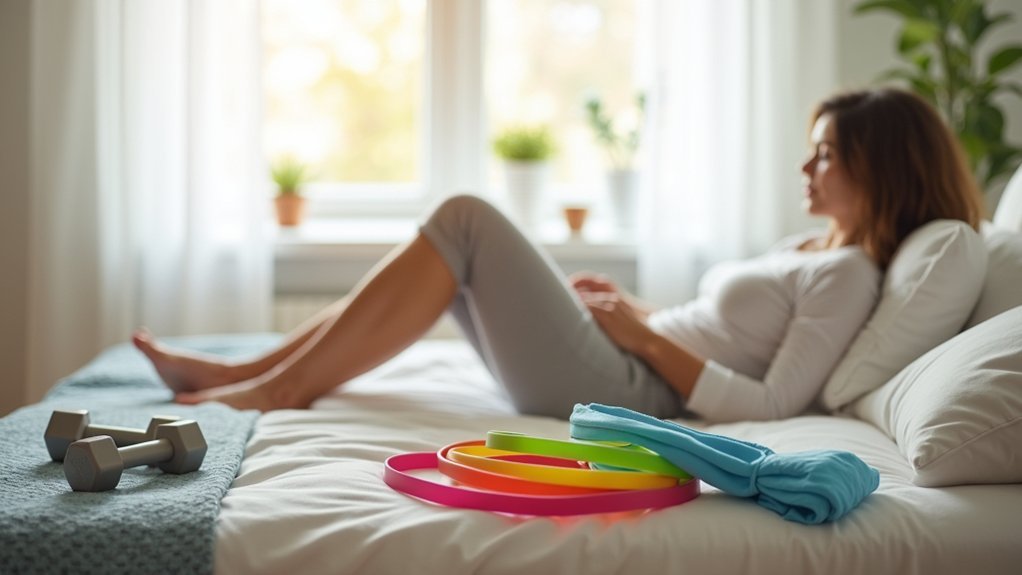Bed exercises work exceptionally well for limited mobility because they maintain muscle strength while preventing dangerous atrophy (which occurs at 1% daily when inactive). You’ll improve circulation, reduce blood clot risks, and maintain joint flexibility without standing. These movements release mood-boosting endorphins and can be safely performed with proper alignment. With adjustable positions and caregiver assistance when needed, you can effectively strengthen your core, upper body, and lower extremities while protecting vulnerable joints and tissues.
Why Exercise In Bed Works For Limited Mobility

While many assume effective exercise requires standing or sitting upright, bed-based movement provides essential benefits for those with limited mobility. When you’re confined to bed, your muscles can weaken at an alarming rate—approximately 1% daily—but simple exercises help maintain strength and prevent atrophy.
Your adjustable hospital bed creates an ideal environment for safe movement, supporting proper alignment during various exercises. These bed exercises greatly improve blood circulation, reducing your risk of dangerous complications like blood clots and pressure sores that often affect people with limited mobility.
Movement in bed isn’t just exercise—it’s protection against serious health complications that threaten those with limited mobility.
Daily movements such as ankle pumps, heel slides, and leg lifts maintain joint flexibility and range of motion, preserving your functional independence despite mobility constraints.
These accessible exercises turn your bed into an effective workout station, supporting recovery without traditional workout demands.
Understanding the Benefits of Bed-Based Movement
Although often overlooked, bed-based exercises deliver powerful benefits for those with limited mobility. When confined to bed rest, you lose approximately 1% of muscle mass daily, but exercise helps prevent this muscle atrophy. Simple movements like ankle pumps and leg lifts improve circulation, reducing risks of blood clots and pressure sores.
| Benefit | Impact | Emotion |
|---|---|---|
| Muscle Preservation | Prevents 1% daily loss | Empowerment |
| Circulation | Reduces clot risk | Relief |
| Joint Flexibility | Maintains range of motion | Freedom |
| Mental Health | Releases mood-boosting endorphins | Joy |
Just 10 minutes of focused movement can greatly improve your physical condition and mental wellbeing. With adjustable hospital beds, you’ll find it easier to position yourself for safe, effective exercises that maintain mobility without straining your body.
Core Strengthening Exercises While Lying Down

Even when confined to bed, you can build significant core strength with properly designed exercises. Your core muscles—the foundation of all movement—respond well to targeted work in a lying position, helping stabilize your trunk and improve overall mobility and functional abilities.
Simple exercises like leg lifts and bridges can be performed with minimal resistance, making them ideal for recovery after surgery or during injury rehabilitation. You’ll notice improved balance and posture as you strengthen these muscles, reducing your risk of falls during shifts between positions.
Regular exercise prevents muscle atrophy while maintaining functional strength. If you’re using a hospital bed, take advantage of its adjustable features to optimize your positioning during your exercise routine, ensuring proper alignment and increasing your comfort and consistency.
Upper Body Conditioning Without Standing
Despite being confined to bed, you can achieve notable upper body strength through properly designed exercises that don’t require standing. Incorporating resistance exercises while lying down helps prevent muscle loss and improves flexibility, all while enhancing circulation and reducing blood clot risks.
| Exercise | Benefits | Difficulty |
|---|---|---|
| Arm Lifts | Builds shoulder strength | Easy |
| Shoulder Shrugs | Reduces neck tension | Easy |
| Resistance Band Pulls | Increases upper body strength | Moderate |
| Palm Stretches | Improves hand flexibility | Easy |
| Neck Rolls | Enhances mobility | Moderate |
Using resistance bands creates versatile workout options tailored to your capabilities. These exercises support rehabilitation by preserving crucial muscle mass needed for recovery. You’ll find that consistent upper body conditioning from bed not only maintains strength but also greatly contributes to your overall mobility and independence.
Lower Extremity Workouts for Bedridden Individuals

You’ll find leg strengthening exercises like leg lifts and heel slides essential for maintaining muscle tone while confined to bed.
Ankle mobility routines, including ankle pumps and rotations, help improve circulation and prevent stiffness in your lower extremities.
These simple yet effective movements can greatly reduce your risk of developing blood clots and pressure sores, while preserving the strength you’ll need for future mobility.
Leg Strengthening While Supine
When confined to bed, maintaining leg strength becomes essential for preserving mobility and independence. You can perform leg strengthening exercises while supine to maintain muscle strength, preventing the 1% daily muscle loss that occurs without movement.
These exercises also boost blood circulation in your lower extremities, reducing clot risks.
- Leg lifts help maintain hip flexor strength while lying flat
- Heel slides improve knee flexibility and quadriceps function
- Regular supine exercises create a foundation for advanced mobility later
- With caregiver support, you can gradually increase intensity as you improve
- These movements enhance hip and knee range of motion, critical for functional mobility
Ankle Mobility Routines
Maintaining ankle mobility remains essential for bedridden individuals, as these joints can quickly stiffen without regular movement. Ankle pumps are a fundamental exercise where you simply point your toes up and down, preserving range of motion and preventing contractures.
These simple ankle mobility routines do more than maintain flexibility—they boost circulation, greatly reducing your risk of blood clots when movement is limited.
Try performing heel slides 5-10 times to encourage knee movement while strengthening your lower body connections.
For more extensive benefits, incorporate leg lifts by raising one leg while keeping the other straight. This develops control and strength throughout your lower body.
When practiced regularly, these exercises effectively prevent muscle atrophy and maintain joint health, making them valuable components of bed-based exercise programs.
Range of Motion Exercises to Prevent Joint Stiffness
You’ll keep your joints functioning properly with gentle movements that maintain their full motion range, even while confined to bed.
Regular joint mobilization prevents the stiffness that can lead to painful contractures and permanent mobility loss.
These exercises also fight muscle atrophy, preserving the strength you’ll need when reverting back to more active movement patterns.
Gentle Joint Mobilization
Joint stiffness can quickly develop if you’re confined to bed, making gentle movement essential for long-term mobility. Daily gentle joint mobilization exercises prevent contractures and maintain flexibility, even when you can’t leave your bed.
These simple range of motion movements activate muscles around your joints, supporting strength and overall joint health.
- Ankle pumps and heel slides improve circulation and reduce blood clot risk
- Daily practice prevents permanent tightening of muscles and tendons
- Regular mobilization enhances your ability to perform everyday activities
- These exercises maintain joint flexibility despite limited movement capabilities
- Consistent gentle movements support long-term joint health and function
Preventing Muscle Atrophy
Muscles begin to weaken and shrink at an alarming rate when you’re confined to bed, with research showing approximately 1% daily muscle loss in hospitalized patients. To combat this, range of motion exercises are vital even when physical inactivity seems unavoidable.
| Exercise Type | Benefits | Frequency |
|---|---|---|
| Ankle circles | Prevents calf atrophy | 3-5 times daily |
| Arm raises | Maintains shoulder mobility | Every 2-3 hours |
| Leg slides | Preserves hip function | 10 minutes per session |
Just 10 minutes of consistent movement can greatly improve your strength retention and joint health. Don’t underestimate the power of caregiver support during these exercises—having someone to guide you guarantees proper technique and provides motivation. With their help, you’ll maintain muscle integrity and joint flexibility despite limited mobility.
Circulation-Boosting Movements for Prolonged Bed Rest
When confined to bed for extended periods, maintaining proper blood circulation becomes essential for preventing serious complications.
Circulation-boosting movements can considerably reduce your risk of developing blood clots and pressure sores during prolonged bed rest. These simple exercises help propel blood through your veins, supporting cardiovascular health even when mobility is limited.
- Perform ankle pumps by flexing your feet up and down to enhance venous return
- Practice leg lifts while lying flat to engage larger muscle groups
- Rotate your ankles in circular motions to improve blood circulation to your feet
- Bend and straighten your knees regularly to stimulate blood flow
- Incorporate small, frequent movement sessions throughout your day rather than one longer session
Breathing Techniques to Enhance Bed Exercise Effectiveness
Maximizing your bed exercises requires proper breathing techniques like diaphragmatic breath control, which engages your core and delivers oxygen efficiently to working muscles.
You’ll find pursed-lip breathing particularly beneficial when fatigue sets in, as it helps prevent oxygen debt and reduces anxiety during more challenging movements.
The box breathing technique—inhaling, holding, exhaling, and pausing for equal counts—can become your secret weapon for maintaining focus and stability throughout your exercise routine.
Diaphragmatic Breath Control
As you prepare to exercise while confined to bed, mastering diaphragmatic breathing becomes essential for maximizing your limited mobility workout benefits.
This technique engages your diaphragm fully, promoting deeper oxygen exchange during physical activity while strengthening your core stability.
- Place your hand on your abdomen and feel it rise with each inhale
- Focus on expanding your belly rather than lifting your chest
- Incorporate 3-5 deep breaths before each exercise movement
- Use this breathing pattern to enhance muscle engagement during exercises
- Practice regularly to improve your body’s efficiency at preventing pressure sores
Pursed-Lip Breathing Benefits
Pursed-lip breathing complements diaphragmatic techniques as another powerful respiratory method for bed-bound individuals seeking to optimize their exercise routine. This technique improves lung function by slowing your breathing rate and increasing oxygen intake—essential when you’re working with limited mobility.
When you incorporate pursed-lip breathing into your bed exercises, you’ll notice reduced shortness of breath and enhanced relaxation. This exercise can help control your breathing rhythm, preventing hyperventilation while promoting better blood circulation and muscle oxygenation.
Beyond the physical benefits, this breathing method supports your mental focus during activity. You’ll likely experience less exercise-related anxiety, making your sessions more enjoyable and effective.
For those with limited mobility, pursed-lip breathing transforms simple bed exercises into more thorough therapy for both body and mind.
Box Breathing Technique
While maintaining physical fitness in bed, box breathing serves as a powerful complement to your exercise routine. This structured breathing pattern—inhaling, holding, exhaling, and holding again, each for four counts—enhances your bed exercises considerably when mobility is limited. Your body benefits from improved blood oxygenation while your mind achieves greater focus.
- Box breathing reduces anxiety, creating an ideal mental state for physical activity.
- You’ll notice improved pain management during movements, making exercises more comfortable.
- Your lung capacity increases with regular practice—crucial if you have limited mobility.
- The technique guarantees better muscle function and endurance during bed workouts.
- You’ll experience deeper relaxation while simultaneously preparing your body for exercise.
When integrated into your routine, box breathing transforms bed exercises from simple movements into thorough wellness practices that support both physical and mental health.
Adaptive Equipment for Enhanced Bed Mobility
For individuals with limited mobility, specialized equipment can transform an ordinary bed into a functional exercise space.
Bed rails and trapezes provide secure grips for repositioning, while bed rope ladders help you pull yourself into sitting positions, enhancing your range of motion during bed mobility exercises.
Transfer poles offer stability when shifting from lying to sitting or standing, making your movements safer and more controlled.
Electric hospital beds allow adjustable positions that maintain proper alignment while reducing physical strain during exercises.
Patient lifts, both mechanical and hydraulic, enable caregivers to safely transfer you between surfaces without risk of injury.
This adaptive equipment not only promotes independence but also expands exercise possibilities, ensuring you can maintain strength and flexibility despite mobility limitations.
Progressive Resistance Training From a Reclining Position
Progressive resistance training offers a powerful way to build strength without leaving your bed.
You’ll find this approach particularly effective if you’re facing mobility challenges, as it targets specific muscle groups while your body remains supported.
Using resistance bands or light weights from a reclining position allows you to gradually increase intensity as your muscle strength improves.
Begin with lower resistance and gradually increase as your body adapts, creating constant muscle challenge from the comfort of your bed.
- Arm lifts and leg raises can greatly enhance your upper and lower body strength
- Adjustable resistance levels accommodate your changing abilities and rehabilitation needs
- Regular practice improves joint flexibility and range of motion, preventing stiffness
- Increased blood circulation reduces the risk of blood clots during extended bed rest
- Consistent training contributes to greater independence and improved quality of life
Mental Health Benefits of Regular Bed Exercise
Beyond strengthening your body, regular exercise in bed delivers remarkable mental health benefits that shouldn’t be overlooked. When you move your body, even from a reclined position, you’ll release endorphins that naturally elevate your mood and combat anxiety and depression.
| Mental Health Benefit | How Bed Exercise Helps |
|---|---|
| Improved Mood | Releases mood-boosting endorphins |
| Enhanced Self-esteem | Provides sense of accomplishment |
| Better Cognitive Function | Increases blood circulation to the brain |
| Reduced Isolation | Creates feelings of autonomy and independence |
| Better Sleep Quality | Lowers stress and improves mental health |
These exercises help maintain your cognitive health through improved circulation, while giving you control over your wellness journey. You’ll likely experience better sleep—a critical factor in maintaining positive mental health and reducing stress levels.
Caregiver-Assisted Movement Techniques
When mobility is limited, having a skilled caregiver can make a notable difference in maintaining movement and preventing complications.
Caregiver-assisted movements enhance your independence while reducing reliance on others for basic repositioning. Working with your caregiver allows you to practice essential bed mobility skills in a safe, controlled environment.
Partnering with your caregiver creates a foundation for developing mobility skills that foster greater self-sufficiency.
- Bend your knees and use your elbows to push during weight shifts for better stability
- Practice rolling with your caregiver guiding your hips and shoulders to minimize discomfort
- Shift to sitting with assistance to build confidence and strength
- Establish regular movement routines to prevent muscle atrophy and improve circulation
- Communicate with your caregiver about comfort levels during positioning adjustments
With consistent practice, you’ll develop increased competence in bed mobility, considerably reducing risks associated with prolonged immobility.
Preventing Pressure Sores Through Strategic Movement
Pressure sores pose a serious risk for those with limited mobility, yet strategic movement while in bed can effectively prevent their formation. You’ll need to reposition yourself every two hours to distribute body weight evenly across different skin surfaces.
Incorporate simple bed exercises like ankle pumps and leg lifts into your daily routine. These movements stimulate blood circulation, which is essential for maintaining healthy skin and preventing ulcers.
Using mobility aids such as bed rails or trapezes can help you change positions safely without assistance. These tools empower you to move independently and reduce pressure on vulnerable areas.
Even gentle stretches and regular position changes contribute markedly to skin integrity.
Frequently Asked Questions
What Is the Best Exercise for People With Limited Mobility?
For people with limited mobility, your best options include ankle pumps, heel slides, leg lifts, arm exercises, and gentle stretching. You’ll benefit from consulting a physiotherapist to tailor these exercises to your specific needs.
How to Get Into Bed With Limited Mobility?
Position your wheelchair close to the bed, use transfer aids like boards or poles, and bend your knees when sitting on the edge. Don’t hesitate to ask caregivers for help during the shift.
Are Exercises in Bed Effective?
Yes, bed exercises are effective. You’ll maintain muscle strength, improve circulation, and prevent complications like blood clots. Even short 10-minute sessions can greatly enhance your flexibility and mobility while safely using adjustable bed positions.
Can I Exercise While Laying in Bed?
Yes, you can definitely exercise while laying in bed. You’ll benefit from movements like leg lifts and arm raises that maintain muscle strength, improve circulation, and prevent atrophy—especially helpful if you have limited mobility.
In Summary
When you’re limited in mobility, bed exercises aren’t just convenient—they’re essential. You’ll improve circulation, maintain muscle mass, and boost mental health without leaving your mattress. By incorporating these accessible movements into your daily routine, you’re actively preventing complications while building strength from where you are. Remember, any movement counts, and with consistency, you’ll experience meaningful physical and emotional benefits despite your mobility challenges.





Leave a Reply